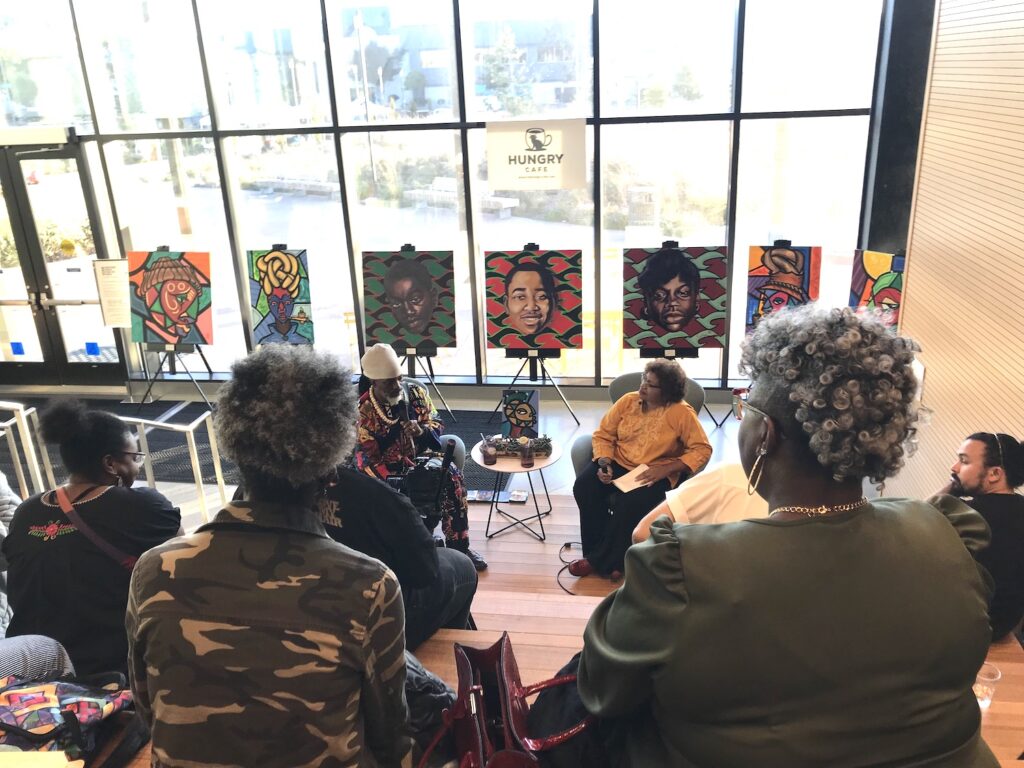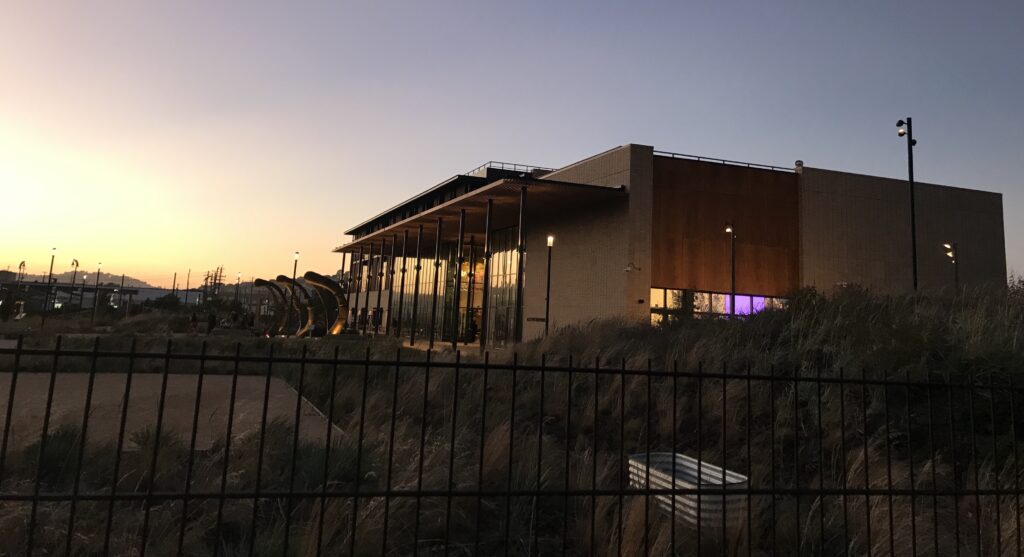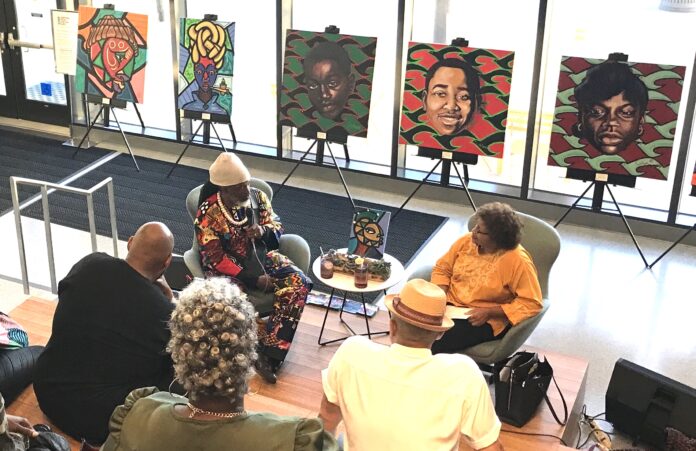Within a vibrant California native plant garden next to a $100 million community center, Matthew Haramut sells his all-natural vegan plant-based moisturizer. But this isn’t Cole Valley or Hayes Valley, the other farmers’ markets frequented by Haramut’s “Black-owned, queer-owned business.” This is the corner of Third and Evans in the Bayview, a San Francisco neighborhood more familiar with poverty and pollution than plant-based cosmetics.
“It’s the first year so, like anything, it takes time,” Haramut says about the small but lively market, which was popping last Thursday. “It’s going to get even better. I just have hope.”

The Bayview knows the powerful resolve, as well as the heavy disappointment, that hope yields. On this warm fall evening, though, the buzzy anticipation of revered local Bayview artist Malik Senfaru has Haramut on the happy side of hope.
“He’s an amazing person,” Haramut says when asked about the subject of the night’s signature event inside the center, Art, Trauma, Resilience, a Conversation: Malik Seneferu and Denise Pate. “His art speaks volumes about our community. And I hope that everybody comes down and experiences his exhibit for themselves.”
A few booths down, Chris Wakefield of Bayview Community CO-OP has a specific hope: to reverse the systemic discrimination against the Bayview, one box at a time.
“It’s a food apartheid issue,” Wakefield says. “A lot of the food that comes into San Francisco has to come through the SF Market, and most of that leaves. So people who live here have little access to organic, healthy food. Despite the fact that it’s housed here and processed here.”
Wakefield pinpoints what the Bayview has in common with many poor, urban neighborhoods. It’s not just that redlining forced communities next to the power plants, sewage treatment plants, and intense areas of industry that wreaked havoc on their health. It’s that those communities rarely benefit from that industry—or even have access to the jobs that create those products.

Wakefield has not met Seneferu, but when he hears about the artist’s backstory, like overcoming childhood chronic asthma caused by Bayview pollution, Wakefield nods in admiration.
“Sounds like he’s living a multifaceted life.”
Inside the community center, a towering wall of windows makes the festive Farmer’s Market outside feel inside. Mohamed Ali, founder of the center’s Hungry Cafe, agrees with Wakefield’s food mission for the Bayview.
“Hungry Cafe is focused on fresh food for the Bayview. It’s been a food desert.”
He sees a crossover purpose in tonight’s farmers’ market and Senefaru’s talk: the consumption of meaningful art and nutritious food as building blocks for a healthy community.
“Malik is an artist from the Bayview, and that made 100% sense for us to host this kind of activity. And Malik is a great artist.”
Thirty or so attendees find spots on the steep, deep, wooden steps that serve as seating for the main event. Elders from the past, who worked tirelessly to transform the Bayview, peer down from gold-leafed sculptured blocks in Phillip Hua’s masterful “The Big Six,” in conversation with the seven easels of Seneferu’s colorful series of portraits, “From the Hill and Beyond.”
The bold colors of the portraits get their blaze from Senefaru’s life—growing up in low-income housing projects and listening to the early stages of hip-hop, later travels to Kenya and Haiti, encounters with figures like Henry Ossawa Tanner and Jean-Michel Basquiat.
Oji Elliott, a Bayview native and local artist who is inspired by nature (“If you pinch yourself, Mother Nature will feel it”) shares how Seneferu has inspired his art.
“It comes down to taking care of ourselves,” Elliott says. “You have to take care of yourself in order to take care of others.”

Seneferu, with long dreadlocks and colorful garments from head to toe that match his paintings, settles into an armchair facing Pate, who wears a bright yet more subdued outfit. Whatever style differences they have, they are kindred spirits and both 100% Bayview, which Pate makes clear from the top.
“I’m a descendant of the families that came during the Great Migration,” Pate, Director of Community Investments at the San Francisco Arts Commission, says. “So my grandfather came in 1942 to work on the Shipyard.”
It soon becomes clear that there would be no separation between life and art in the discussion. For Senefaru, his life is his art. And he leads off with a memory that taught him if artists can make money with their craft, everyone wins.
“One indelible moment is coming to my grandmother’s barbershop and getting my hair cut. Watching her own a business taught me that owning a business was different, wasn’t akin to having a job.”
“And that was an invaluable thing for me to see. With that experience, I knew I wanted to serve the community.
The Hunters Point Shipyard was a childhood playpen for Senefaru (“we used to try to scale those fences just to see what was on the other side”), as well as the place where his parents met and fell in love.
“My father was a Navy SEAL who spent time at the Shipyard. Mary’s was right there on the corner of Donahue, and my parents met there. So had there not been the Shipyard, I probably wouldn’t be born. That’s the bittersweet side of it.”
Senefaru is well aware of the tragic side of the Shipyard, with its interminable toxic cleanup, as well as all the other polluters and ailments in the community that led to his battles with childhood asthma.
“I remember going to meetings with my elders and hearing them talk about the problems with the Shipyard and how they wanted to close down the Shipyard. Like Marie Harrison, who is no longer here with us.”

Senefaru is grateful for the guidance he received from his mentor Joe Sam, who created STAR, the Shipyard Artist Residency Program, to support Malik’s art. (The program continued after Malik moved on.) Both STAR and the San Francisco Art Commission, which explained grant opportunities that night, want Bayview artists to know they have support.
Senefaru details how he needed every inch of that support growing up. If dealing with pollution induced asthma and a community cratered out by the loss of the Shipyard wasn’t enough, the blow that kneecapped the community was The War on Drugs and mass incarceration of the 1980s during the crack epidemic. Senefaru shared his amazement at how his community changed almost overnight.
“I remember me and my friend one summer weekend walking down the street, and we saw a car full of guns. And there used to be a whole group of us would get on the bus to go to school. And next thing you know, nobody else was around.”
“And then a friend of mine showed me $1,500. I’m like, What is this? What are we talking about?”
“So I put together that a picture speaks a thousand words. If you saw my first series, they were called The Raw, talking about the raw essence of what was happening. So you might see a painting of a crowd around a kid who’s been shot.”
During the Q/A, audience members are eager to understand how he remainedrooted in his community, despite so many leaving the Bayview. Senefaru’s answer is as bright and personal as the bold faces behind him.
“Hugs,” he answers with a smile. “Four hugs a day will give you safety in the hood. Eight hugs a day gives you security. And then 12, you have survival. So the hugs on my grandma, the hugs from my mother, the love is what really kept me.”
“When you meet guys who are really from Hunters Point, you’re talking about families who are rooted in love.”







